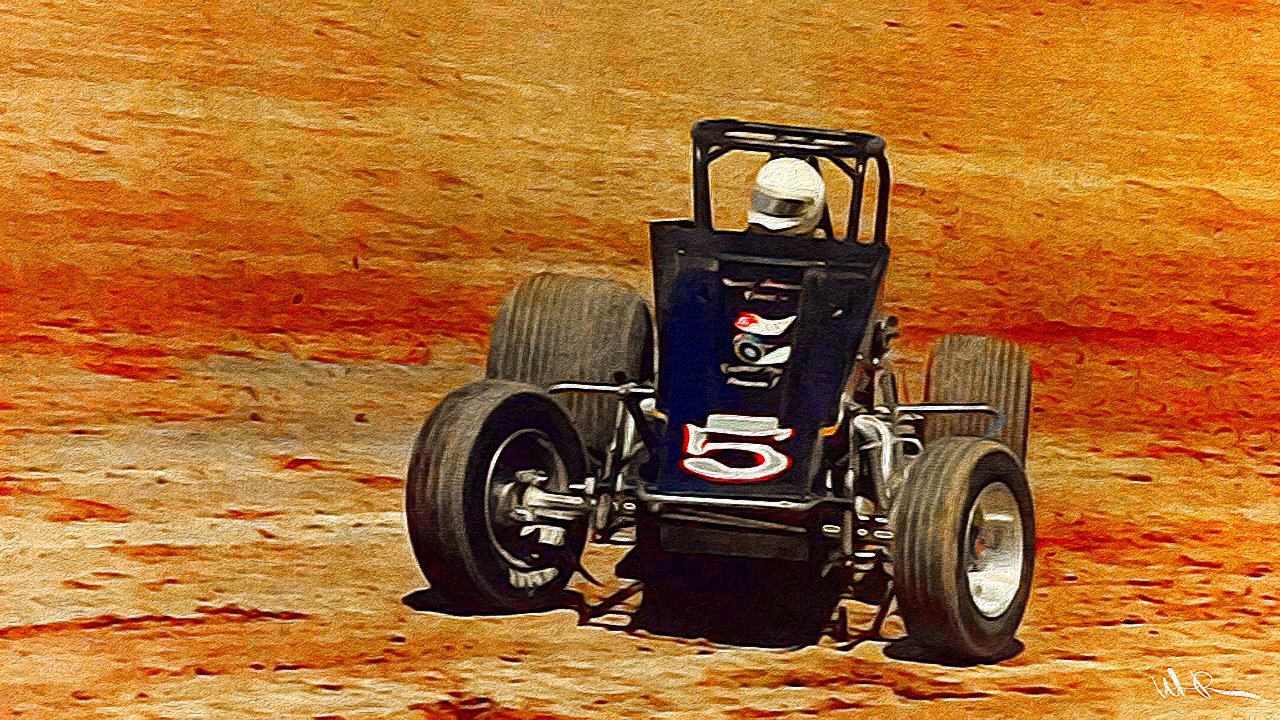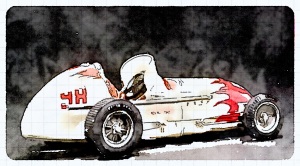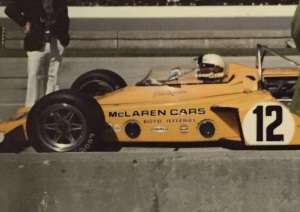There is a free, yes free, copy of Racer Magazine 2015 IndyCar Special available at http://www.racermagazine-digital.com/racer/2015_indycar_special/m3/Document.action?lm=1427110704000
Lawrenceburg Speedway
The 2015 Lawrenceburg Speedway has been released. Come out and see what real open wheel racing is all about.
lawrenceburgspeedway.com
ALL’S WELL IN NASCARLAND
The new season is off to a great start for NASCAR – Lots of crashes, confrontations on pit road, Tony flips the verbal bird on Twitter and little Jeffy gets his farewell season pole for the 500. One might actually think this was planned. NAAAAWWWWW! Nudge, Nudge, Wink, Wink.
UPRIGHT
The 1952 Indy 500 was the scene of several historic events. The race was won by Troy Ruttman who remains the youngest 500 winner at 22 years 80 days. He also was the youngest driver to score points in the World Driver’s Championship (F1) for his 52 Indy win until eclipsed by Fernando Alonzo in 2003. Between 1950 and 1960 Indy was part of the World Driver’s Championship but most teams based in Europe did not compete at Indy. In 1952 only Ferrari driver Alberto Ascari appeared at Indy. The 1952 pole was won by Fred Agabashian in the Kurtis Kraft Cummins Diesel which has the distinction of being the first turbocharged car to be raced in the 500. In addition to the 33 starters there were 31 non-qualifiers.
Just as historic as Ruttman’s win was the number 98 “Agajanian Special” he drove for the legendary owner A. J. Agajanian. Agajanian entered cars at the Speedway from 1948 through 1971 and scored 3 poles and 2 wins – the other win coming in 1963 with Parnelli Jones at the wheel of the Watson roadster “Old Calhoun” also numbered 98. Ruttman’s ride was a Kuzma Offy Dirt Car which was commissioned by Agajanian from Kuzma’s shop in late 1950. It first appeared in the 1951 500 as the “Grant Piston Ring Special” driven by Walt Faulkner carrying the number 2. It was the only Kuzma car in the 1952 race and was the last upright dirt car to win the 500. Powered by a standard period Offenhauser engine it sported a springer “suicide” front suspension then common on dirt cars. The car continued to be campaigned on both dirt and pavement tracks by various owners until at least 1965. I was unable to find any evidence of participation after 65. In 1964 Bobby Unser, driving the car for the “Lynch Mob”, qualified 7th for the pavement race at Phoenix, still sporting its famous “A” front nerf bar. It was restored to its 52 Indy livery by Bruce Meyer who traded it to the IMS Museum in exchange for the Wittington Brothers LeMans winning Porsche 935 and is now in the Hall of Fame Museum.
They sure don’t build them or race them like they used to.
© Through the Catch Fence 2015
Almost Perfect 1947-1949
In the years 1947 – 1949 the Blue Crown Special sponsored race team owned by Lou Moore nearly found perfection at the Indianapolis Motor Speedway. The Deidt chassis cars were the first to be powered by the new 270cid Offy engine. They were front wheel drive and employed 4 wheel disc brakes.
The 1947 race was won by Mauri Rose driving the number 27. The race was not without contreversy. Bill Holland driving the other Moore car had a substantial lead over Rose when both were give the sign board to ease the pace. Rose ignored the instruction and continued to push, only to be waved by by Holland who thought Rose was a lap down. They finished Rose first, Holland second. Both Holland and Moore were furious with Rose.
The 1948 finish was less eventful but the result was the same. Mauri Rose, driving the number three easily outdistanced Holland for the win with Holland once again finishing second.
Once again in 1949 contreversy arose between Rose and Holland. With Holland, in the number 7, leading Rose once again ignored a pit board telling him to take it easy. He again tried to pass Holland for the win only to have the car fail and finish 13th. Holland went on to win the race. Moore immediately fired Rose after the race.
Moore’s Deidt Offys went on to score additional top tens with other drivers. They last qualified for the 1951 500. From 1947 – 1949 the cars had 3 consecutive wins and 2 consecutive seconds at the Brickyard.
The cars in the above photos are 1/43 scale models produced by and available exclusively at Replicarz (replicarz.com). The quality is superb, the photos do not do them justice, and the price is very reasonable.
text and photos
© throughthecatchfence – 2015
THE RICH KID
The “Rich Kid” – that’s what the veterans called Peter Revson when he arrived in Indianapolis in 1969. The nickname stuck but the respect level went way up when he finished 5th after starting 33rd in the 500. Rookie of the Year was awarded to Mark Donohue even though he finished in 7th, 10 laps behind Revson.
Revson was the nephew of and heir to the Revlon Cosmetics magnate Charles Revson. There is some dispute about just how rich he really was but Peter was known to comment that he wished he was as rich as people thought he was. He qualified for 5 Indy 500s with a pole in 1971; 3 top 10s with a best finish of 2nd in 71. Overall in Champ Cars he had 1 win, on the road course at Indianapolis Raceway Park in 69, and 3 poles.
Revson had some brief experience with F1 in the early 60s in non-works cars and returned for a one-off in 71 with Tyrell. In 72 he was hired by McLaren and raced for them through the 73 season. In that period he had 1 pole (Canada 72), 2 wins (Britian and Canada 73); and had 8 career podiums. He finished 5th in the World Drivers Championship in both 72 and 73. He remains the last American born driver to win an F1 race (Mario was born in Italy). In addition his overall racing resume includes a class win at the 12 Hours of Sebring in 66, 2 TransAm wins in 67 and he drove a factory Ford GT40 at LeMans in 67.
Revson’s greatest success came in the CanAm seies in 71 when he won 5 of 10 races and became the first American Champion of the series. It would be his only major series championship. For the record the CanAm series was a closed wheel, open cockpit series which raced from 1966 to 1987 except for 75 and 76. CanAm cars were brutally powerful and were clearly the fastest road racing cars of their era, and perhaps of all time. The McLaren M8F that Revson drove to the championship was powered by an 8.3 litre normally aspirated Chevy V8 and was capable of lapping faster than its contemporary F1 cars.
In 1974 Revson switched to the UOP Shadow F1 team. While testing at Kyalami for the GP of South Africa a titanium front suspension component failed and Revson crashed heavily. There is some disagreement about the crash with some reports of the car submarining a single armco barrier (photos of the scene clearly show a double height guard rail) while others report that the car flipped over the barrier. In either case Revson was killed, probably instantly.
There are some interesting footnotes to Revson’s racing career. He is credited as a “driver” in the Transportation Department (not as a member of the cast) in the 1966 film Grand Prix. A footnote to this footnote is that also credited in the film, as a “Camera Operator” is one George Lucas (yes the Star Wars George Lucas). Revson partnered with Steve McQueen in a 2nd place finish at the Sebring 12 Hour in 1970.
Revson’s autobiography (co-authored by Leon Mandel) “Speed with Style” was published posthumously in 1974. It is a good read and I’m happy to say I have a first edition in my racing book collection.
© throughthecatchfence 2015
Back to Basics
With the start of the 2015 racing season at hand, for me the Daytona 24, it’s time to pick up a pen (a quaint thought) and get back to basics. When the 2014 racing season came to an end I intended to do my annual year end wrap-up. I reviewed my 2014 posts and notes and came to the conclusion that most of my posts about 2014 were snarky and critical while my posts about the past were primarily positive. As a result I have decided to focus on historical events, drivers, tracks, and cars. My opinion of the current state of racing in general is very low. I really have little confidence in the future of motorsports, particularly in America. The only bright spots are short track racing and grassroots motorsports. Never fear however for I am certain that I will have a few snarky comments about the 2015 season. So here we go.
THE LARRY AND GARY SHOW
When I was reviewing my 2014 notes I was reminded of the recent death of Gary Bettenhausen and the first thing to come to mind was the “Larry and Gary Show”. For those of you who are saying “Huh?” this was what we old-timers call the 1968-1971 USAC Sprint Car seasons. I pulled out my old USAC yearbooks and magazines and refreshed my memory. I took a shot and “googled” it and found very little additional information, although there was a good deal of info about a radio show also called the “Larry and Gary Show”. There was one intriguing hit, a reference to an article from May 26, 2014 in the British newspaper “The Independent”. I could not imagine in what context a USAC Sprint Car rivalry would fit in a 2014 British newspaper article. I pulled it up and it was an article about the then raging rivalry between Mercedes F1 drivers, Lewis Hamilton and Nico Rosberg. The article then went on to discuss other famous F1 rivalries of the past and finally reached the conclusion that F1 had never produced a driver rivalry the likes of the “Larry and Gary Show”. The fact that a British newspaper would recall a USAC Sprint car rivalry more than 45 years later only confirms the legendary nature of this on track feud.
Just the facts:
USAC Sprint car season standings:
1968: 1st – Larry Dickson 2nd – Gary Bettenhausen
1969: 1st – Gary Bettenhausen 2nd – Larry Dickson
1970: 1st – Larry Dickson 2nd – Gary Bettenhausen
1971: 1st – Gary Bettenhausen 2nd – Larry Dickson
68 – 71 Total USAC Sprint car features: 128
68 – 71 Dickson wins: 29
68 – 71 Bettenhausen wins: 27
Percentage wins by Dickson and Bettenhausen combined: 44%
I was fortunate enough to witness a few of these races.
Larry Dickson came to USAC Sprints 1966 and was successful almost immediately. Gary Bettenhausen arrived on the scene in 1967 and soon began challenging Dickson for superiority which set the stage for the next 4 years of outright war. The fundamental basis for the rivalry was the fact that they were both vastly talented and aggressively competitive; and each one was convinced he was the best. They raced each other as if there were no other competitors on the track. It was the same high banks or flat track; pavement or dirt; day or night.
Was this a friendly rivalry or pure hatred? It was probably close to, but not quite, hatred. There was respect but absolutely no give and take. It was reported that Dickson had a photo of Bettenhausen taped to his steering wheel center pad so that he could punch him during the races. I never saw the picture myself but it would not surprise me if this was true.
Both Dickson and Bettenhausen eventually made it to the 500, neither had great success, but Bettenhausen clearly having the better Champ Car career. Apparently they eventually became friends — after the “show” was over.
©Through the Catch Fence 2015
LATE START IN EDT
For those of us Eastcoasters/Midwesterners who don’t intend to stay up until 2AM EDT or who will be attending a local short track this Saturday evening.
SPOILER ALERT:
The Verizon driver, driving the Verizon car, will win the Verizon Series which was attended primarily by Verizon employees with comp’d tickets.
RESPECT
I’ve been hanging around short tracks since the late 50’s – mostly between 68 and 84. I watched the “Gary and Larry Show” weekend after weekend. I saw Opperman and Patterson and all the early outlaws break into and out of USAC. I saw Jeff Gordon run the dirt. Short tracks weren’t quite as deadly as they had been a few years earlier but the specter still hung over the banks. I cannot remember a driver getting out of a wrecked car and walking across a track to confront a moving car. I think that for the most past the wrecked driver was so relieved to be unhurt that the instinct was only to get the hell over the wall or into the infield as quickly as possible. I saw a lot of fights in the pits long after the checks and the trophies were distributed.
The first time I can remember a driver getting out of a car and confronting a moving vehicle was in NASCAR. I’ve seen Tony Stewart do it several times. Last Saturday Kevin Ward Jr. did just what his hero, Tony Stewart, would have done if the situation was reversed.
I think driver safety is the single most important issue in racing today and I don’t mean to imply anything to the contrary. However, it is clear that the level of safety currently existing, even at the weekend racer level, is such that drivers have completely lost respect for the danger they encounter each and every time they strap in.
What’s missing from racing is RESPECT – respect for speed, respect for danger, respect for one another.
TRAGIC
I have been sitting here for over 4 hours trying to understand what happened last night at Canandaigua Speedway with Tony Stewart and the death of Kevin Ward Jr. I didn’t want to watch the video but I did – it’s inconclusive. Nobody knows what was going through Tony’s head at the time and nobody ever will unless he chooses to tell us. I assume he had a radio and a spotter, if so what was communicated at the time might cast some light on the situation. What do we know? It was completely avoidable and I think that says it all.
This incident will cast a long shadow over racing; NASCAR; Sprint Car racing; Stewart-Haas and it’s sponsors; Tony Stewart; and especially the Ward family and friends for years to come. RIP Kevin.





